|
| History of American Firms in France! (#4) |
|
My Ph.D. dissertation!
In November 2013, I obtained a Ph.D. in History at the Sorbonne with a dissertation on "The American Chamber of Commerce in France and American Firms in France 1890-1990 : Harmony and Dissonance" |
|
|
|
English Summary
American firms in France have been studied from 1890 to 1990, from the archives of the American Chamber of Commerce in France (AmCham). This source provides the elements of an analysis of the collective actions they implemented and the influence they had on French firms over five successive periods where there was more or less a consistency between their actions and the US government’s decisions.
In the first period (1890-1914), AmCham was a club of wealthy businessmen in a prestigious environment. In the second one (1914-1945), it was an employer’s association, with more members but in a context of wars and crisis, without a common strategy. In the third one (1945-1970), it was an efficient instrument of the Marshall Plan and later of the American challenge (*). In the fourth one (1970-1990), with a growing number of firms, with the European project gaining ground, US policy’s reluctance to FDI and US firms becoming more and more « frenchized », significant factors of fragility appeared and finally in the fifth one (after 1990), AmCham, whose influence has diminished, is trying painfully to identify new elements of solidarity between its members in the new context of globalization with the growing influence of European decisions on national policies.
From this source, the study focuses on cultural interactions between AmCham and its environment and the spread of the American management model, which led to a large frenchization of American subsidiaries in France.
(*) In French : le defi americain. In 1967, a book by French journalist Jean-Jacques Servan-Schreiber was a huge success. Observing the enormous flow of US investment in Europe, it predicted that, in 1985, the third world economic power, after the US and Russia (!!!), would be US Firms in Europe. This forecast proved wrong but it stimulated European firms to grow by successive mergings. |
Click here to ro read the full dissertation (Warning : it is in French and it weighs 10 lb when printed!)
A few examples of the field covered and studied in the dissertation :
- Events :
- The 1900 Paris Exhibition
- The direct participation of AmCham : to improving storage and delivery of US imports (1917-1919), to chairing quota committees (1934-1937), to offering American licences to French firms in the frame of the Marshall Plan (1950-1952), ...
- American firms during the German Occupation (1940-1944)
- The influence of US policy on foreign direct investment (1970s)
- The Franco-US crisis about the Siberian pipeline (1981-1982)
- French spying on US firms (1980s)
- ...
- Historical facts :
- The link between American firms and local American associations
- The cluster complex (US firms bringing with them US lawyers and consultants)
- The emergence of a new generation of French managers in US subsidiaries
- ...
|
Presentation of the thesis : A history of American firms in France from 1880 to 1990 : coherence and dissonances
In American historiography, relatively few studies(1) have been devoted to the development abroad of firms and France is rarely considered. American firms in France have been studied in French historiography either within the framework of sectorial studies, like the automobile(2) or communication(3) industries, or in the framework of the many studies on multinational firms(4) and their influence has been studied mostly under the angle of the diffusion of modernity(5) .
Of course, each firm implements its own strategy of international development, resulting from its competitive advantages and its position on the market but there is no specific study of the elements of solidarity that firms have in common to accompany their development abroad, namely in France.
This is the aspect that we wanted to study.
A new source...
The archives of the American Chamber of Commerce in France (AmCham) provide a tool that allows to better understand the successive steps taken by American firms, by identifying, over a very long period of time, the collective actions they carried out and the influence they had on their French environment.
However, our research is not a monography and we used a global approach : the study of the collectivity of US firms, practically since they came to France at the end of the 19th Century.
A new approach....
We thought it was particularly interesting and new to study if and when firms engaged in common actions(6) , what kind of common forces were involved and which objectives they shared.
The thread to follow in our research was to take into account the transfer of innovation, made easier by physical proximity and whose main vector is likely to be sharing the job market of managers and executives between French and foreign firms.
This why we gathered many biographical elements on around one hundred personalities.
Our study covers a century between two major ruptures. 1890 is the date of the 11th US Census, when the first Hollerith machines (the origin of IBM) were used and which puts an official end to the concept of frontier : it is the begining of the international development of US firms. 1990 after the fall of the Berlin wall, is a landmark of triumphant globalization and disappearance of the frontiers for commercial trade. Our work could be summed up in the formula « From the end of the frontier in the US to the end of national frontiers » .
The problem of sources
Limiting our research to French sources was a preliminary choice and an exploratory survey of American diplomatic archives had lead us to the conclusions that :
• in the enormous quantity of documents, references to American subsidiaries and their strategies seemed to be absent or exceptional
• a punctual and random use was unlikely to bring up any key element whereas an intensive and systematic use would change our subject into « the study of American foreign policy toward France », which is not our subject.
One could imagine using American sources for a shorter and/or an older period but it was neither possible nor useful for a period one century long and ending in 1990.
Although lacunary, the AmCham archives represent a source exclusively focused on our research ; it is an original one and it has not been systematically exploited before.
Of course, this source has important weaknesses and limitations : too « controlled » and prudent, it is only an indicator which must be amplified.
Our main deception is the unanimous refusal of cooperation of US subsidiaries : only a couple of them gave us access to very few uninteresting documents and all of them declared that they have kept absolutely no document beyond legal obligations, which is obviously wrong.
The main results of the research
Since the end of the 19th century, the flow of American subsidiaries in France and the nature of their interaction with their French environment has gone through several very different stages. We tried to identify, for each of them, the elements of coherence and dissonance of the actions of the firms between themselves and with regard to the policy of the US government.
The first period shows coherence without dissonance
| Before 1914, AmCham was an association of businessmen. International trade was limited and custom barriers generated recurrent conflicts between governments. American firms were very scarce and the first pioneers wanted above all to become part of an environment which was difficult for them and where they admired the "French industrial art" that they considered they would never be able to challenge. |
They created AmCham to represent themselves to the French authorities and the US government and, meanwhile, a structured community of Americans in Paris started developing not only to link people who have to face a foreign environment but also to help them resist the attacks from their own government for whom expatriates are considered more like « traitors to America » than as tools of power ; this is an American specificity. We analyzed the strength and the necessity of the link between companies and local American associations.AmCham’s lobbying took place within the framework of total loyalty with regard to the US government, as illustrated by its defense of the Payne-Aldrich Act (1909) that it disapproved. Toward its host country, AmCham, an « ethnic institution »(7) behaved as a respectful and elegant member of the society, as did its presidents Stephen H. Tyng and Walter V.R. Berry.
A « conservatory of urbanity »(8), AmCham generated actions which contributed to helping the American economy to become conscious of its strength, for instance by its participation in the Paris 1900 World Fair. However, in 1914, the presence of American companies remained very limited, particularly for industrial firms. Most of them were traders, lawyers (such as Coudert Brothers) and banks. |
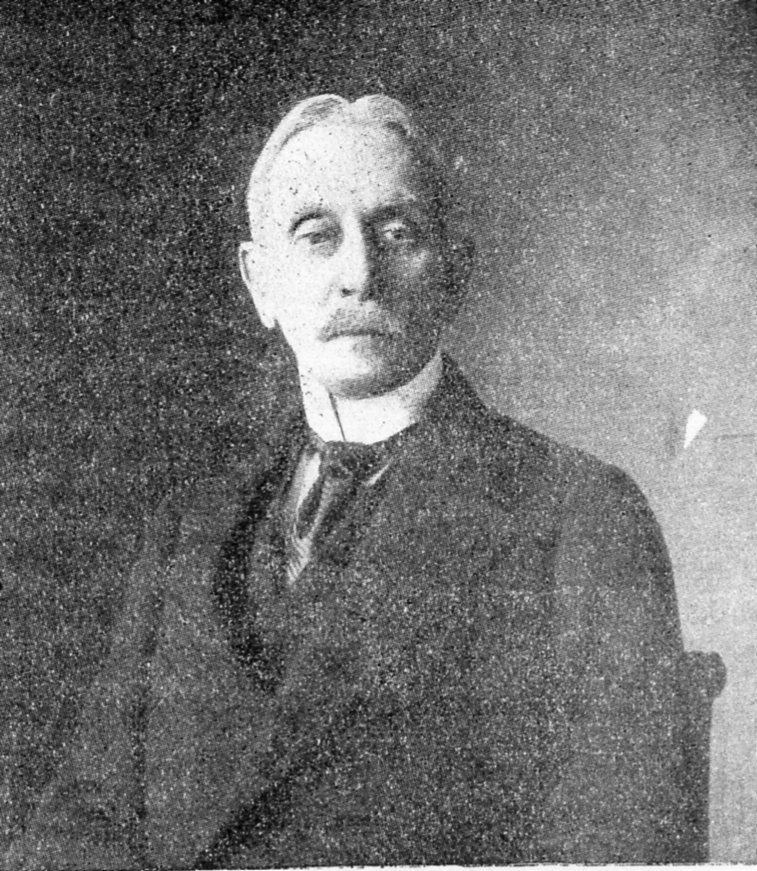 |
| Walter Van Rensselaer BERRY (1859-1927), lawyer, President of AmCham (1917-1922) |
| During this time as solidary pioneers in a prestigious world, AmCham was following a logic of shop-keepers, its influence was, globally, very limited but all its members shared the same objectives. It was a time of coherence without dissonance. |
With war came a long period of incoherence and dissonance
| Through war and crisis, US firms tried to maintain their solidarity in spite of political conflicts (concerning war debts) and, between the two world wars, AmCham followed with difficulty the hesitations and the changes of policy of the US government whose attitude toward foreign investment was versatile(9) ; it forced US firms to constant adjustments and did not encourage industrial investments. |
Obliged to adopt an « opportunist » strategy, they did not easily find common interests and objectives and their influence remained limited. Unable to control them, AmCham followed the erratic variations of its environment, and the representatives of US firms participated in complex and often adventurous operations such as the sale of US war surplus by the Auxiliaire de l’AmCham after 1918 or the organization of quota commissions in the 1930s.
We chose Arthur Baldwin (General Electric), the president of AmCham and the head of a cartel (electric lamps), to illustrate this period.
However, to resist European competition and to skirt custom protections, US firms had to reinforce their presence in France and the only available option was to manufacture there but very few were ready for that. They hesitated about the form to adopt : to license, to build a joint-venture or to consider a greenfield investment. However, no standard model of investments can be identified(10) and there were many failures.
We propose a quantified typology of investments, different from Wilkins’ and based on the security in the conservation of innovation capacity, distinguishing stable and transitory forms of investment.
During the two world wars which open and close this period, AmCham adopted a feigned neutrality and a real solidarity with its host country. However, even when sucessful, AmCham actions are characterized by ambiguity, risks of speculation or conflicts of interest and the whole period show incoherence and dissonance. |
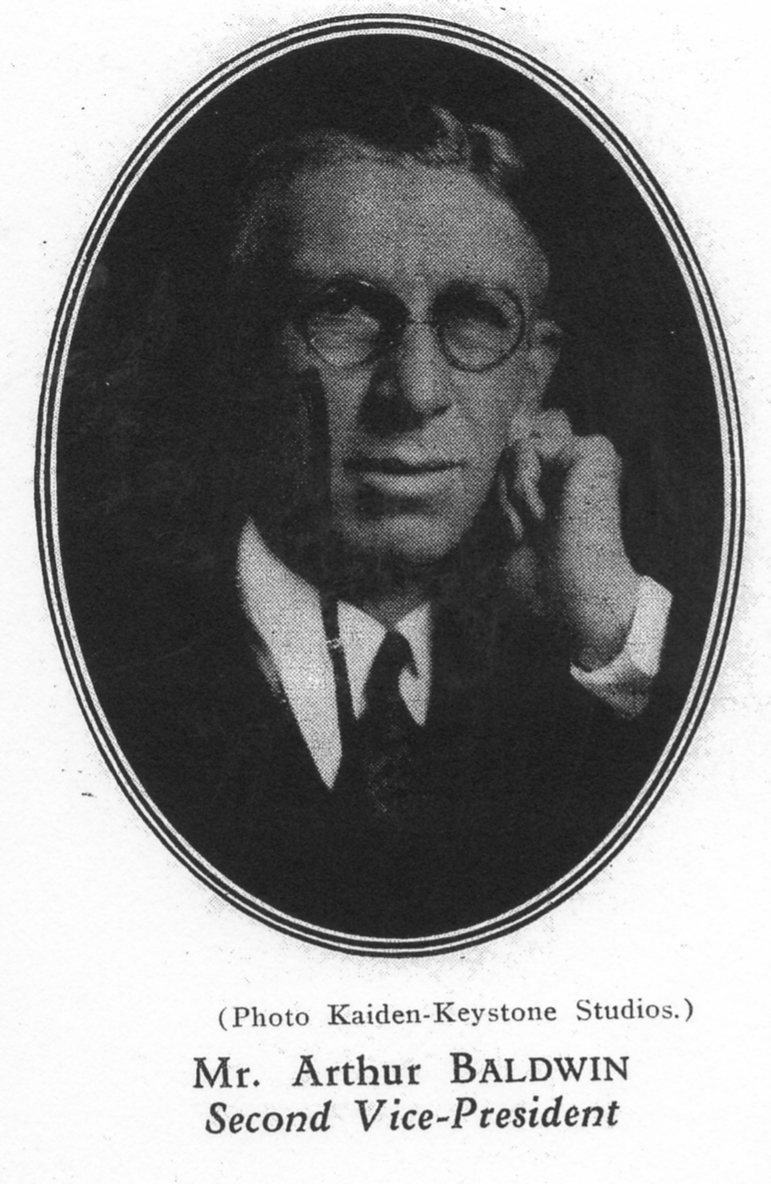 |
| E. Arthur BALDWIN (1874-1947), President Europe International General Electric, President of AmCham (1934-1937) |
| |
Again coherence without dissonance after the Liberation of France
From 1945 to 1970, US firms discovered new elements of solidarity and, illustrating the American efficiency for the conquest of markets and the diffusion of managerial practices, AmCham contributed actively to the methodical conquest of the markets and of the French society, thus becoming an efficient tool of the American domination.
The French economy had to be strengthened while maintaining US superiority and AmCham was an active player in the Marshall Plan, in particular with the European Liaison Office which it housed, and it definitely helped French companies in their efforts to discover the American market.
With the development of more American factories and the realization of the American Challenge, AmCham was confronted to a political and social environment which was sometimes hostile (from the Communist Party and later from Charles De Gaulle) and it had to show a real solidarity between its members. Negotiations with French authorities, in a difficult political and monetary environment for them, were unequal and American firms, with the help of their lawyers and tax experts, often made the legal and regulatory framework evolve to their benefit : to this regard, the 1955 negotiation led by AmCham about the de facto exoneration of royalties to head offices, is a perfect example of this dissymetry. |
AmCham gives us a new tool for observing the Americanization of French firms, particularly in the field of human relations.
After the conquest of markets, minds too should be conquerred : the American model became predominant and AmCham contributed actively to it. The new sector of strategic consultants accelerated the convergence of French and US firms toward a common model, in spite the persistence of intercultural differences(11) .This phenomenon translated into a new generation of French managers like Jacques Maisonrouge from IBM (or : « America explained to the French ») or Hubert Faure from OTIS (or : « France explained to the Americans ») we were lucky enough to meet for long interviews |
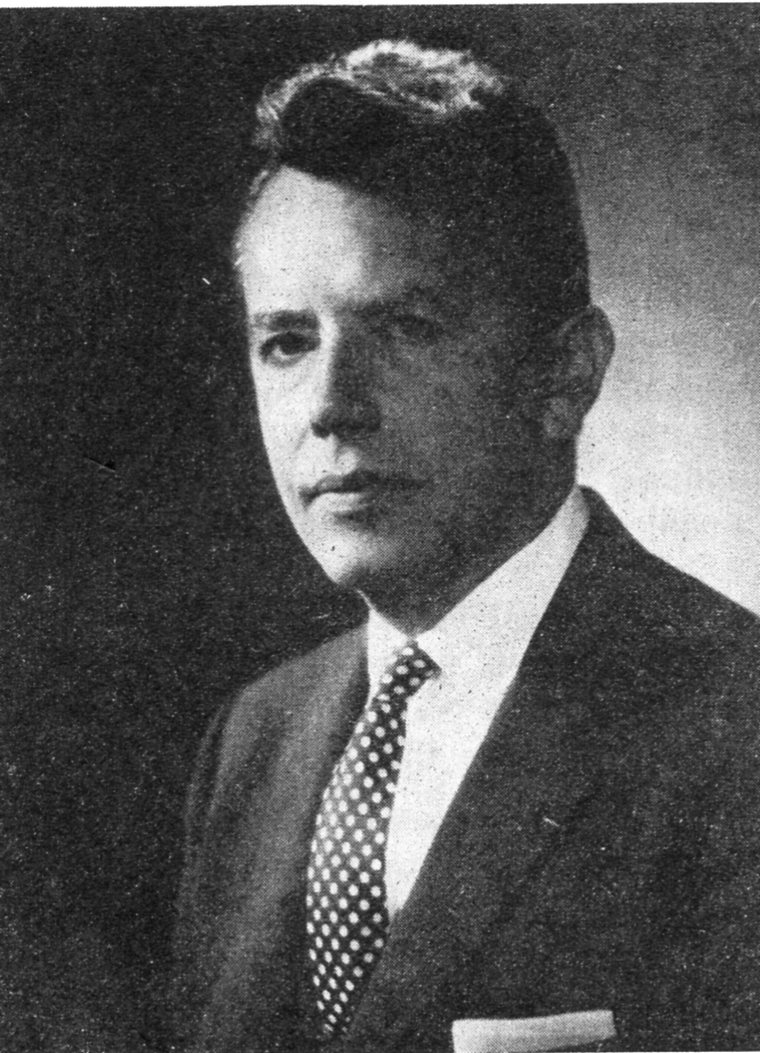 |
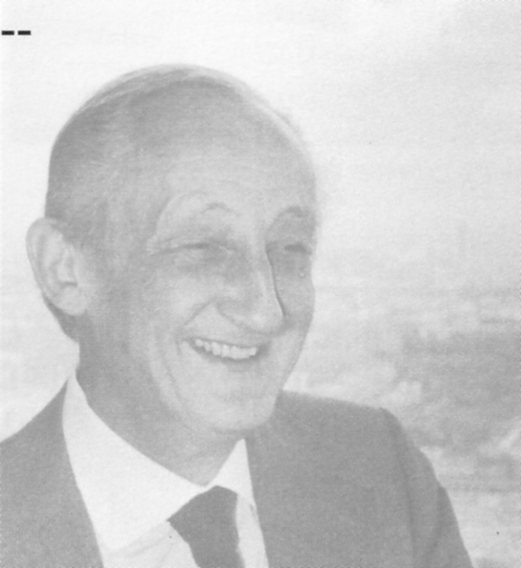 |
| Jacques MAISONROUGE (1923-2012), ECP, President IBM World Trade, Member of the Board IBM Corp. |
Hubert FAURE (1919-2012), President OTIS Corp. |
.During this period, many American companies invested in France to benefit from lower costs, to attack the European market and to limit the growing competition from European firms. These « conquerors » had a clear common strategy and had set up the organizations to implement it, even against the obstacles created by their own government.
Just as before World War 1, it was again coherence without dissonance. |
After 1970, there is still coherence but dissonance appears
| At the opening of our 4th period, a very important rupture was created by the evolution of the policy of the US government, which multiplied monetary and regulatory obstacles to the development of US firms abroad. Simultaneously, around this date, the elements of solidarity which had united the firms of the American Challenge became less determinant and the representativity of AmCham diminished abruptly and significantly, illustrating the observation of Olson about the weakening of the possibilities of collective actions of organizations when they become bigger. |
Given the cost of expatriates and the realization of the increasing quality of local managers, a real « Frenchization » of French subsidiaries took place progressively, creating a form of dissociation of cultural values between the firms and the French society. This Frenchization(12) reached AmCham itself, where American board members became a minority. Simultaneously, the diffusion of innovation and particularly of managerial innovation, in French companies rebalanced the relation with US firms, with the hiring of managers and executives trained in American methods and through the R&D centers created by US groups in France. The diffusion of innovation took place also in State-owned bodies, as illustrated by the examples of Chronopost and Caisse des Dépôts.
After the signing of a Treaty of Reciprocity in 1959, which could only acknowledge the new rules of global market economy, the element of solidarity around the combat for free trade had disappeared.
But in the Soviet pipeline crisis in 1981-1982, AmCham supported the French position, a major rupture in its relationship with its own government. This conflict illustrated how difficult it is for the US to assign limits to transfers of technology when its own firms manufacture abroad. |
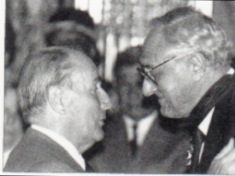 |
| Charles TOREM (1914-1993) (here with President Francois MITTERAND), Managing Partner of Coudert Brothers law firm |
However in spite of the fragility created by the actions of the US government with its restrictive decisions against foreign direct investment or its political pressure as in the case of the Soviet pipeline, AmCham was able to achieve some ambitious collective actions, such as helping the creation of industrial investment in cooperation with DATAR or negotiating tax agreements which became the main element of solidarity, in order to limit (but not eliminate) double taxation.
The American technological leadership had never been so strong, including through the acquisition of innovative French firms which had become a very frequent form of investment (like UTC).
The American member of the business community in France who seems to correspond the best to this period of significant development within a complicated legal and regulatory context is Charles Torem, the managing partner of Coudert Frères, the French subsidiary of Coudert Brothers since 1879 and, practically, the firm which founded AmCham.
In 1990, AmCham had probably reached the apex of its influence : some dissonance had appeared but there was still a high level of coherence. |
But after 1990, what level of coherence is left with the loss of previous landmarks ?
| What are the main lines of evolution after 1990, the end of period of study ? We have tried to identify some of them through the compared evolutions of AmCham France and AmCham EU (Brussels) and with the study of some significant disappearances (like Coudert’s in 2005). |
With the end of the predominence of bilateral relations, AmCham became a simple association of firms, lost most of its reference marks and doubted its future. In spite of an important flow of direct American investment, AmCham entered a period of crisis, as most other foreign organizations in France did, including American.
But can we still refer to « American firms in France » after 1990 ? The building of Europe has blurred the borders between states and in a global world, the proximity to markets does not have the same meaning any longer and technological transfers no longer demand physical nearness.
With the loss of these marks, AmCham is now less and less representative and it has lost most of its industrial base in spite of its efforts to regain the big companies it had lost. The presence of French executives, now a majority, makes it more difficult to maintain its American character. To illustrate this period, one could choose Denis Hennequin, the president of a company (McDonald’s) which is emblematically American but denies its Americanness and has never been a member of AmCham. |
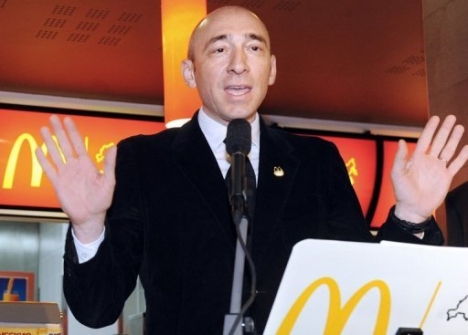 |
| Denis HENNEQUIN (born 1958), President of McDonald's Europe |
| |
In short ...
A common tool of companies, AmCham embodied collective strategies which were different and even contradictory from one period to another :
• the will to integrate the economy and the French society or, on the contrary, the will to make it change to get closer to the American model
• the will to encourage French companies to export to the USA or on the contrary the defense of American protectionist decisions of the US government
• being a club of wealthy businessmen or an asssociation between firms or finally a meeting structure for mostly French executives
Our study validated our hypothesis : for a period of one century, the American Chamber of Commerce adequately expressed in its actions the successive strategies of its mandators : first an efficient tool for integrating the High Society, then an instrument for erratic and sometimes doubtful initiatives, then the very efficient machine for an economic and cultural conquest and finally an institution in search of its object in a world where all its previous marks have disappeared.
What is new in our approach ...
What seems to be new results from the main source itself and maybe from the use of tools and references unfrequently used in French historiography.
Regarding common actions, we saw the importance and the persistence of tax issues for the firms as well as for their expatriate executives, the consequence of the concept of extraterritoriality(13) which is inherent to the American legal system and the conflict between the personality and the territoriality of laws which encourages the creation oftax loop holes to attenuate double taxation.
Our analysis bring a somewhat new light on the hybridization of practices of firms to adjust to their environment. It shows that it is not possible to study the group of US firms without studying the community of American residents whether or not they are expatriate executives, as illustrated by the support of AmCham to AARO in 1973-1976 on citizenship issues. More studies on American associations in France will certainly bring new interesting views.
Other than, of course, the interest of completing and confronting our research to American sources, several other aspects that we encountered seem to deserve further research :
• the history of American firms during the German occupation needs to be written as well as the history of the relations of US firms with the French colonial empire ;
• we tried to evaluate the flow of US investment(14) over a very long period with regard to the form of the investment : it would be very interesting to compare the situation in France with other European countries which received significant US investment (UK, Germany, Belgium or the Netherlands) ;
• the role of the sector of services to business, as an illustration of the cluster complex(15) , and the interaction with consulting and auditing firms to explain the diffusion of the American model and the decline of representativity of AmCham certainly deserve more research, also comparative ;
• crossed representations also enrich the analysis of soft power and we believe that the integration within the field of French historiography of intercultural parameters classically used in the field of management(16) studies would bring a fruitful additional angle. For that, a statistical study of the Americanization of French firms based of the career paths of French executives over the period 1970-1970 would certainly be fruitful ;
• and finally, the history of financial innovation in the 1980s and its diffusion within the French financial system will raise fascinating subjects, particularly for risk models, structured finance and titrization.
As a conclusion ...
Our research may contribute to a new perspective on the French economy and on the economic relations between France and the USA in the 19th century, possibly transferable to other European countries, by using as a tool the analysis of the collective actions led by the US firms in a foreign country.
|
References :
- Ch.Kindleberger 1971, M.Wilkins 1970, 1975 et 1991, J.Dunning 1980
- P.Fridenson 1994
- P.Griset 1993
- JL.Mucchielli 1998
- D.Barjot 1997 & 2002, H.Bonin 2009, Ch.Bouneau 1993
- M.Olson 1971
- As studied by N. Fouche.
- N.Fouche 1999
- See G.Herring 2008 about the policy of monitoring of bank loans and about the rivalry between the Department of Commerce and the Department of State.
- J.Dunning and the eclectic paradigm (OLI : Ownership, Location, Internalization).
- Ph.D’Iribarne 2002
- R.Kuisel 1993 et 2012
- The porcelain war 1911 (p.160), US custom inspections in France 1928 (p.223), FATCA 2010 ; see Art. 164 CGI (France) and IRC-Section 911 (USA) and the case of Disneyland Paris
- With the increasing proportion of joint-ventures.
- As identified by M.Wilkins.
- See in particular R.Hall 1981 and G.Hofstede 2001.
|
The defense and the jury
The thesis was defended in the Sorbonne university, with a jury of 5 highly regarded professors composed of :
- Pr. Pascal GRISET, professor at Paris 4-Sorbonne University, who had been my advisor
- Pr. Eric BUSSIERE, professor at Paris 4-Sorbonne University, president of the jury
- Pr. Christophe BOUNEAU, professor at Bordeaux 3 University, rapporteur
- Pr. Helene HARTER, professor at Rennes 3 University, rapporteur
- Dr. Laure QUENNOUELLE-CORRE, Senior Researcher CNRS
The defense was held on November 21, 2013 and the jury granted me the highest academic distinction awarded for doctorates within the French academic system ("Mention Tres Honorable avec Felicitations Unanimes du Jury"). |
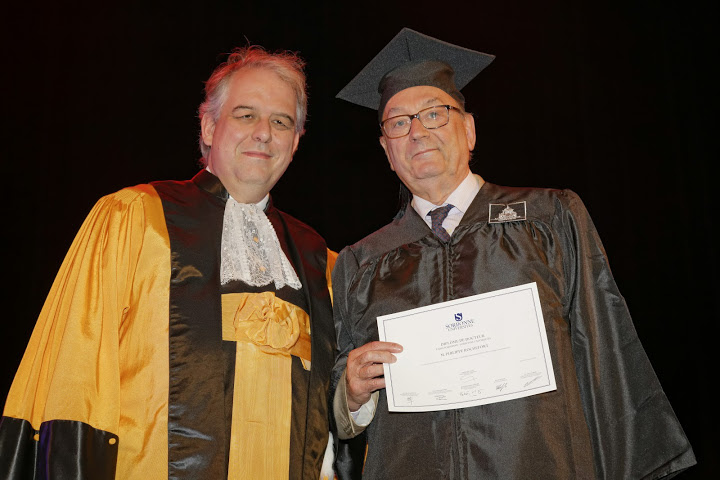 |
| Philippe Rochefort with Pr. Barthelemy Jobert, President of Sorbonne University, during the ceremony for the Ph.D.s of 2013, in June 2014. |
|
To related pages : American corporations in Paris, doing business in France, working in Paris, see my resume, the diary of an old student, etc. |
To table
of contents
To top of the
page
Back to home
page |
Harriet Welty
Rochefort writes articles and books about France and the French.
Order her books :
- "Joie de Vivre", Secrets of Wining, Dining and Romancing like the French, St.Martin's Press, New York, 2012
- "French Toast, An American in Paris
Celebrates The Maddening Mysteries of the French", St.Martin's Press,
New York, 1999
- "French Fried, The Culinary Capers
of An American in Paris", St.Martin's Press, New York, 2001
More on Harriet's books (excerpts, upcoming
events, testimonials, etc..) |
Philippe Rochefort gives
P-to-P training sessions
for executives newly assigned to France
More details... |
| To email
me |
Together
or separately, Harriet and Philippe speak
about Intercultural Differences : click
here for information.
|
|